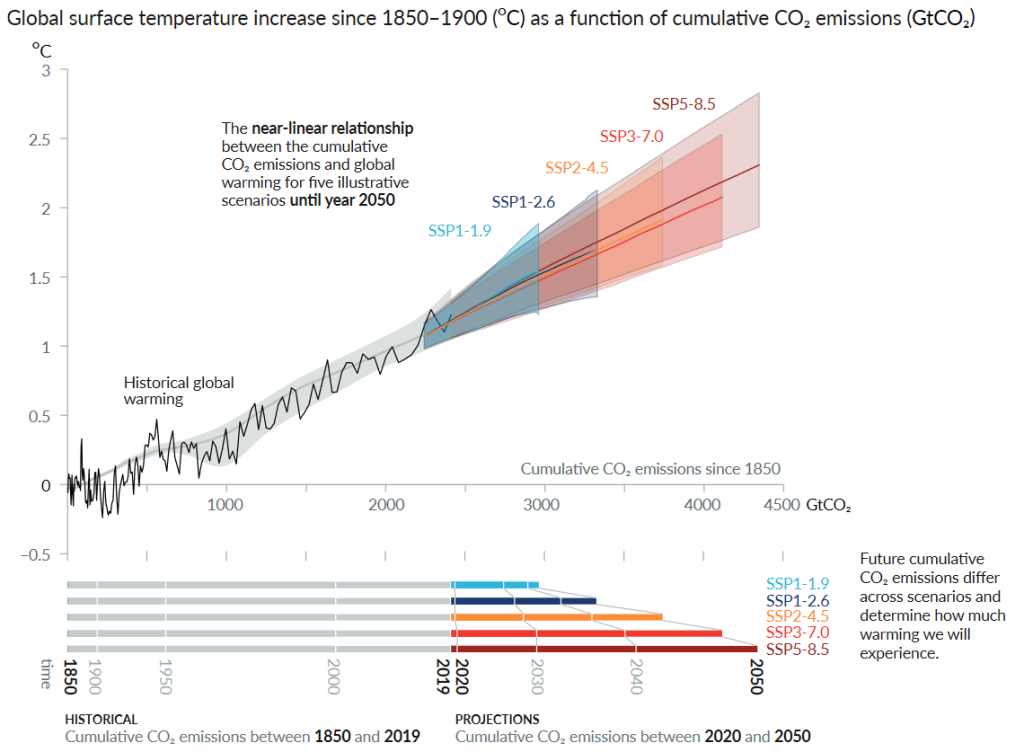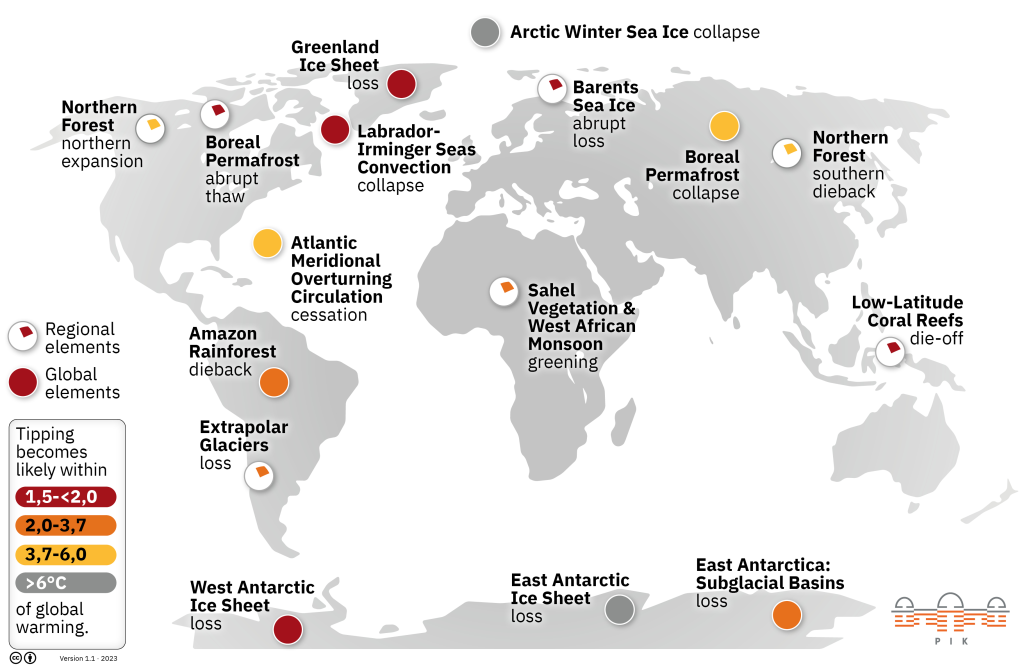3 fundamental truths about climate change
facts & figures, opinion Aug 27, 2024

Oh yes, we’re living in interesting times with surely no shortage on emergencies and crises, that may leave you feeling like humankind is steering towards an inevitable, almost Orwellian, dystopian future. In order to deal (or not to deal) with that, some choose to simply ignore, doubt or even work against any kind of evidence whatsoever. (And I’m even sure you know someone of that sort – looking forward to the next family gathering, aren’t we?).
But fear no more! This post is intended to equip you with a full range of brutally physical and non-negotiable truths, that will arm you e.g. for the next table discussion that you will (in)voluntarily get dragged into. But instead of making the same mistakes as many other people, you will be able to steer the conversation into a fruitful direction and start discussing the important things. And if not that, then you will be at least less likely to become a victim of modern fake news campaigns.
Post Summary
The three things you are invited to take away are:
- Humanity must eventually cease all (net) greenhouse gas emissions
- We must strive towards limting global warming below 2°C
- The earlier we take action, the more time we have
Further down it is explained, why we know this for a fact and hence why it is a waste of time doubting these things. Instead we need to accept unchangeble truths and should focus on actually discussing solutions towards a just, fair and effective mitigation of climate change.
# 1) Net-zero CO2 emissions must be the goal
In 1856, just a decade after the discovery of Neptune, it was shown by Eunice Newton Foote that CO2 is a greenhouse gas, meaning it absorbs infrared radiation and hence “traps” heat in Earth’s atmosphere. Despite humanity being aware of this key effect for almost 170 years now, it seems that the obvious consequence of this is not yet fully understood by every policy maker.
The more CO2 in the air, the greater the warming.
Of course this is valid for any greenhouse gas, but when talking about global warming on a high-level, the general impact of all gases is usually expressed in units of CO2 equivalents to keep it simple. So, regardless if we talk about carbon-dioxide (CO2), methane (CH4), nitrous-oxide (N2O) or any other greenhouse gas you can think of: The more we humans bring into the atmosphere, the higher Earth’s temperature rises.

Source: IPCC, WG1, AR6 (2021): Summary for Policymakers, Figure SPM10 1
And of course we can measure it! Take a look at figure 1: When comparing the cumulative CO2 emissions (so the sum of all the CO2 emitted in the past) with the rise in global surface temperatures, one sees an almost perfectly linear connection. From that we can estimate which amount of emissions correspond to what degree of warming, shown by the colored scenario pathways.
However, you might ask: But what if we extract the amount greenhouse gases from the atmosphere, that we emitted in the first place? The answer to this could fill another blog post (that probably will come in the future as well), but long story short: We will not be able to do this on the large scales that would be required to offset our emissions. In the end there is no other way than to avoid emitting greenhouse gases completely.
# 2) Keep Earth below 2°C of warming to prevent worst cases
The next step is to find out: How much greenhouse gases are left to emit? And for that to deduct, we need to find out how much warming humanity can afford, before our home turns against us. And of course, you already know the answer, since you’ve probably read the headline…. But how did people come up with this threshold 2°C? And what about 1.5°C? Wasn’t that a thing, too?
In 2015 humanity came together and decided to limit Earth’s warming well below 2°C and furthermore to make significant efforts to stay below 1.5°C. The latter part might sound like a vague promise (and it might even be), but there are nations (e.g. pacific island states) whose future depends on not coming too close to 2°C of global warming. Figure 2 is a schematic display of global warming thresholds. The colors indicate in a very intuitive traffic-light way, that the lower, the better. Note, that these numbers mean an additional temperature rise compared to pre-industrial mean temperatures.

And why now these exact numbers? Various scientists from all over the world regularly gather together all of their knowledge and findings to assess and quantify the consequences of a warmer climate. And the list of possible consequences is long! Certain regions of Earth may become inhabitable hot 2, weather extremes increase in frequency and intensity (i.e. heat-waves, heavy rainfalls, droughts, hurricanes, …), a rising sea-level, acidification of the oceans, desertification, collapse of ecosystems, melting of permafrost, land and sea ice and so on and so on 1.

The figure is created by PIK (cc-by licence) 4.
And to top it all of, there might even be the risk that crossing certain crucial “tipping points” may lead to a global cascade of tipping, causing Earth to gallop into a hothouse state right away, even when all of humanity stops emitting greenhouse gases all at once 5. To illustrate this: The human-caused warming results in the melting of arctic land and sea ice, that might trigger a change in Atlantic ocean currents, that could influence the monsoon, which consequently may cause the rain forests’ dieback, which again increases CO2 emissions, that as a result may cause the collapse of permafrost, causing the release of even more damaging gases like methane, triggering what else not… Now, this is just an illustration and by far not a forecast or a somehow reliable description of a certain development. But it highlights, how interconnected the climate system(s) on Earth are and that playing with a over thousands of years established equilibrium can have dramatic consequences, that are just hard to reliably assess, especially in a much hotter climate. The further way we stay below a 2°C warming, the more certain model projections are.
Just to be clear: Galloping into a cascade of tipping points is just a discussed possibility and not a certain reality. However, the many other impacts are very real and in order to minimize them staying below 1.5°C is worthwhile and staying below 2°C is necessary.
In conclusion, these thresholds are not to be taken as political recommendations, but margins within the climate and eco systems of our planet still work in a somewhat reliable and familiar way. Crossing 2°C goes with dramatic consequences and wider margins of uncertainty.
# 3) The longer it takes, the harder it gets
In the first point, we could conclude that there is only a limited amount of greenhouse gases left to emit. And if the remaining budget is limited, time is also, since humanity is still constantly emitting CO2. In order to grant us as much time as possible for transforming almost everything, we therefore should strive to reduce emissions as soon as possible.
Or to put it the other way around: The longer we wait, the more radical the transformation must be. Even if being already a bit outdated, figure 3 shows how reduction pathways do look like with a set carbon budget. The earlier we start reducing our emissions, the more time we have and the less radical the transformation must be. But if we wait until the last possible moment, we would have to immediately cut off all emissions, which is hardly realistic.

Source: C. Figueres et al. 2017: Three years to safeguard our climate, Nature, 546, pages 593–595 6
To put it in other words: We can buy ourselves time, when starting to introduce easy greenhouse gas reduction methods as soon as possible. And there are plenty of these “low-hanging fruits”. Ban private jets and short distance flights, introduce stricter speed limits in traffic (or any speed limits at all, looking at you German Autobahn), financially promote renewable energies and modern insulated housing and establish a CO2 price with payout of the revenue to all citizens. These things than give us time to work on transforming the harder stuff, like heavy industry, agriculture or long-distance travel.
The above suggestions are alone my opinion. I simply want to emphasize how important it is to discuss exactly this: Opinions. Which measures are good to implement and to what extent? What is fair and reasonable and how establish it? But discussing whether or not we need reduction and transformation measure is just a waste of time, because we already know the answer for a fact.
Talking about the right things
With these three non-negotiable facts in mind, the necessity to fundamentally change how humankind currently deals with resources, in particular fossil fuels, is on hand. One only needs to understand these three things to see, why we can’t go on as before and that there is no alternative to systematically transform all of our economy and society to a new, fossil-free standard.
So, let’s address the important things in future discussions. Instead of questioning whether the whole climate protection thing is really necessary, how about asking the more relevant questions: How do we reach net-zero emission as soon as possible? How do we do this socially fair and internationally just? Let’s discuss different measures and ideas, look at advantages and disadvantages of certain (carbon-neutral!) technologies and decide on which path we want to go. Because we have to choose one – standing still is not an option.
References
- IPCC, 2021: Climate Change 2021: The Physical Science Basis. Contribution of Working Group I to the Sixth Assessment Report of the Intergovernmental Panel on Climate Change [Masson-Delmotte, V., P. Zhai, A. Pirani, S.L. Connors, C. Péan, S. Berger, N. Caud, Y. Chen, L. Goldfarb, M.I. Gomis, M. Huang, K. Leitzell, E. Lonnoy, J.B.R. Matthews, T.K. Maycock, T. Waterfield, O. Yelekçi, R. Yu, and B. Zhou (eds.)]. Cambridge University Press, Cambridge, United Kingdom and New York, NY, USA, In press, doi:10.1017/9781009157896. ↩︎
- Xu, C., Kohler, T. A., Lenton, T. M. & Scheffer, M., 2020: Future of the human climate niche; PNAS, 117 (21) 11350-11355 ↩︎
- David I. Armstrong McKay et al., Exceeding 1.5°C global warming could trigger multiple climate tipping points. Science377, eabn7950(2022).DOI:10.1126/science.abn7950 ↩︎
- Potsdam-Institut für Klimafolgenforschung e.V. (PIK), Tipping Elements Information Webpage, Accessed 24.03.2024 ↩︎
- Lenton, T. M., Rockström, J., Gaffney O., Rahmstorf, S., Richardson, K., Steffen, W. Schellnhuber, H. J. Climate tipping points – too risky to bet against. Nature 575, 592-595 (2019). https://doi.org/10.1038/d41586-019-03595-0 ↩︎
- Figueres, C., Schellnhuber, H., Whiteman, G. et al. Three years to safeguard our climate. Nature 546, 593–595 (2017). https://doi.org/10.1038/546593a ↩︎
Last updated: 27/08/2024